Abstract
Despite increasing global environmental concerns, we continue to consume large amounts of products with little regard to what happens before, during, and after their use. Roughly one-third of the food produced is wasted. Because the world’s population is expected to grow to 10 billion by 2050, adopting circular economy practices will become essential. The transition towards a circular economy requires adopting business processes that support circular economy practices across supply chains. Currently, the SCOR (Supply Chain Operations Reference) model is the most widely used, and widely known, approach for studying and evaluating supply chain business processes. It is, however, unclear to what extent circular principles are included in the SCOR model. Past studies indicating missing processes for circular supply chain management in the SCOR model have made limited efforts in capturing the current state-of-the-practice. We conducted an online survey of 60 companies engaged in 14 different types of economic activities to study the SCOR level 2 business processes adopted in practice. In addition to the 22 level 2 business processes documented in SCOR, we identified six additional level 2 circular business processes that the respondents recognized as being commonly applied within their businesses. The results clearly show that the current SCOR model does not fully represent circular business processes in the state-of-the-practice.
1. Introduction
Despite increasing global environmental concerns, we still continue to consume large amounts of products with little regard to what happens before, during, and after their use. Many supply chains follow a linear model of resource consumption, in which raw materials are sourced, products are made, and the resulting waste products are disposed of. This practice results in large amounts of waste and is untenable, with the world population expected to reach 9.8 billion by 2050 [1]. According to FAO’s latest estimates, roughly one-third of food produced for human consumption is wasted globally every year [2], amounting to about 1.3 billion tons. Not only is the world population increasing, but also the global middle class is expanding rapidly according to the OECD, from 1.8 billion in 2009 to 4.9 billion people in 2030 [3]. This expanding middle class tends to consume increasingly more manufactured items. As a result, many studies call for discarding the traditional linear model of the “take, make, and dispose” pattern of resource consumption [4,5,6,7,8,9,10].
The idea of a circular economy (CE) has therefore increased in popularity and importance [11]. It is a concept for an industrial economy that is restorative by intention and design, replacing the end-of-life concept, closing the material loops, and reducing wasteful resources [4,7,9]. However, the Circularity Gap Report of 2020 notes that only 8.6% of the world economy is currently “circular” [12]. It is therefore important that initiatives are taken to transition to a CE.
The Ellen MacArthur Foundation [7] notes that supply chains are the key unit of action in CE. Supply Chain Management (SCM) includes many decisions concerning, for instance, the sourcing and recycling of materials, and waste produced, and as such is essential in taking actions for the transition to CE. In essence, a supply chain is a system consisting of interacting elements, including products, processes, people, and information to accomplish the objectives of the actors involved (INCOSE, 2015). These elements are interconnected and interrelated through supply chain processes, and it is thus valuable to study and evaluate these processes. The Supply Chain Operations Reference (SCOR) model is a widely used reference model to represent and study supply chain processes [13,14,15]. The supply chain processes are generally categorized as plan, source, make, deliver, return, and enable [16,17].
Even though the SCOR processes have been developed over time through a collaborative effort of many organizations, past studies indicate that processes for circular supply chain management are missing in the SCOR model [18,19,20,21,22]. These studies were primarily theoretical investigations and made a limited effort in capturing the current state-of-the-practice. Therefore, this research aimed to identify the circular business processes in supply chains in the state-of-the-practice through a survey study, and thereby identify the circular processes that may be relevant for the SCOR model.
2. Background
2.1. Circular Economy
Kirchherr and Reike [23] define CE as an economic system in which various approaches are employed to reduce or overcome wastage of products, avoid product “end-of-life”, close the material loops, and ensure that we will preserve the Earth’s resources for future generations to come.
There are different conceptualizations related to CE, such as the material cycles and the “R” frameworks. The material cycles concept is categorized into two components: the biological and technical material cycles. The biological cycle refers to non-hazardous materials, which can easily “return” to the soil. The technical cycle refers to materials that cannot be easily returned to the earth and should therefore be designed in such a way that they can be used in multiple life cycles [6]. The Ellen MacArthur Foundation [24] defines five fundamental characteristics of CE, namely: designing out waste, diversity builds strength, renewable energy sources power the economy, think in systems, and prices should reflect real costs. The most widely used conceptualization of CE is likely the so-called “R” framework, of which the 3R and 6R frameworks are widely mentioned. In this research we adopt the broader 6R framework.
2.2. The 6R Framework
The 6R framework highlights a cradle-to-cradle approach, instead of cradle-to-grave [25]. In a cradle-to-grave approach, after being used, resources are disposed of in the so-called “graves”, such as landfills or incinerators [26]. Alternatively, in a cradle-to-cradle approach, materials maintain their status as resources after each useful life [4,6,27]. The 6R framework consists of the following six concepts: reuse, reduce, recycle, recover, remanufacture, and redesign [25]. These concepts are described briefly below.
2.2.1. Reduce
The reduce principle argues for the reduction in the use of resources. Eco-efficiency is the means to ensure this reduction occurs, according to Ghisellini et al. [11]. Eco-efficiency is the improvement in the efficiency of production and consumption processes.
2.2.2. Reuse
Jawahir and Bradley [9] define reuse as using products or their components in future life cycles after the end of their current life cycle. This ensures a reduction in raw materials used for newer products and components. Similarly, eco-efficiency also ensures the need to reuse or recycle [28]. The European Union (EU) [29] adds that reused products or components are not considered waste if they are used for the same purpose for which they were originally made. This can be undertaken by, amongst others, second-hand retail chains, charities, vintage shops, and online auctions, and by companies taking back products for reuse at the products’ end-of-life [30,31].
2.2.3. Recycle
Any recovery operation in which waste materials are reprocessed into useful products, materials, or substances is defined as recycling according to the EU [29]. This results in a reduction in waste that ends in landfills or is incinerated, and thereby reduces the environmental impact of waste [11,32,33]. The Ellen MacArthur Foundation [7] recognizes three types of recycling, depending on the value the material has after recycling, namely, functional recycling, downcycling, and upcycling.
2.2.4. Recover
The recover principle includes processes of collecting end-of-use products, in order to disassemble, sort, and clean them for use in another future product life cycle [9,32]. The principle includes energy recovery when non-recyclable waste is changed into usable heat, electricity, or fuel.
2.2.5. Redesign
The redesign principle refers to the design of products that could use components, materials, and resources that are recovered [9]. This principle adds to CE because it ensures that materials recovered from earlier end-of-life generations are used as much as possible [34].
2.2.6. Remanufacture
The remanufacture principle refers to restoring end-of-use products to their original or improved state, in which functionality is not lost [9,34]. The process saves resources and related energy, and it reduces the need for recycling [35]. We consider product refurbishment and component remanufacturing to be part of this principle. Product refurbishment refers to returning products to good working conditions through repair and “cosmetic” changes. Component manufacturing refers to extracting functioning, reusable components from used products and restoring them into new ones.
2.3. The SCOR Model
SCM is essential in moving towards a CE and the SCOR model, developed in 1996, can be an essential tool in CE modeling. The SCOR model facilitates smooth communication among supply chain partners through its standard description of business processes, and enables them to evaluate and compare their business activities and performances [16,36]. Huang and Sheoran [36] note that the SCOR model enables the “as-is” state of a business to be captured and the desired “to-be” future state to be derived. The SCOR model has regularly been updated to adapt to the changes in practices [16]. In general, the model contains five main elements, which are processes, practices, performance, people, and special applications. We explain the processes in more detail as they are the main focus of SCOR and of this research.
The SCOR process model is described at three different levels, which are called level 1, level 2, and level 3. The SCOR model focuses on processes that are relevant for representing supply chains such as customer interactions, physical material transactions, and market interactions, and is not concerned with processes such as sales and marketing, product development, and research and development [16].
In SCOR version 12.0, the main processes at level 1 are: plan, source, make, deliver, return, and enable. The plan process includes the planning of most processes in the supply chain. Source refers to acquiring goods and services to meet the planned or actual demand of the company. Within the make process, materials are converted to a product or content is created for services. Assembly, maintenance, repair, overhaul, recycling, refurbishment, and simple packaging activities are thus also considered to be make processes. Deliver refers to the provision of finished goods or services to customers. Return concerns the reverse flow of goods. Finally, the enable process is about managing the supply chain [16].
This research describes processes at level 2. The SCOR level 2 processes of plan, source, make, deliver and return listed in Table 1 are included in this study. Because enable processes were not used in this research, they are excluded. More detailed descriptions of each level 2 process can be found in the SCOR Quick Reference Guide [17].

Table 1.
Level 2 processes of the SCOR model based on the SCOR Quick Reference Guide [17].
3. Methodology
Survey research is generally used to draw conclusions about a wider pre-defined population by collecting information from a sample population [37]. This is relevant for this research because it can help reveal the circular business processes used in practice. The steps of the survey research methodology adopted here are based on the checklist of Kelley and Clark [37], who describe good practice for the conduct and reporting of survey research. The purpose of this checklist is to ensure that a survey study has credible results [37]. Figure 1 shows the steps of this research that are derived according to the requirements of the checklist.
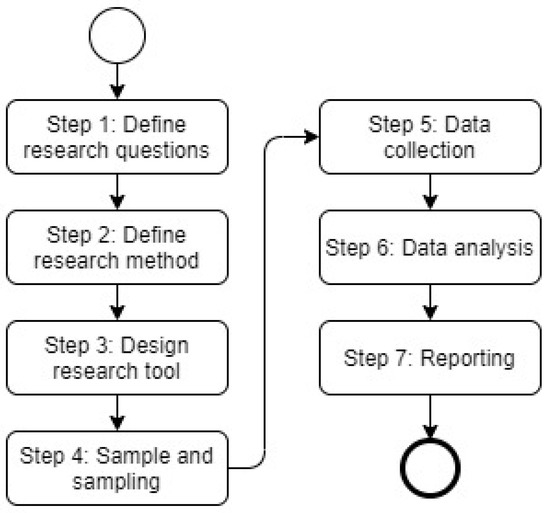
Figure 1.
Survey methodology.
3.1. Research Questions
Through the survey study we aimed to answer the following research questions:
- 1:
- Which business processes have been used in circular supply chains?
- 1.a:
- Which SCOR processes have been used?
- 1.b:
- Which non-SCOR processes have been used?
- 2:
- What are the relationships among the business processes?
3.2. Adopted Survey Method
De Leeuw et al. [38] note that there are many different data collection methods, namely, telephone or face-to-face interviews, mail or Internet/web surveys, and combinations of these. These differ in the type of contact that the researcher has with the respondent. With telephone or face-to-face interviews, the researcher can give additional information, whereas with mail and internet surveys the respondent is dependent entirely on the information and questions given in the survey form [38]. We chose to do a web survey, in which the respondent had to independently fill in an online survey. We needed to reach companies and our respondents would rather fill in a form at their leisure and take as little time as possible.
3.3. Research Tool
We developed questions in Google Forms. The development of survey questions was based on a domain-driven design approach in which we first performed a domain analysis to define the common and variant features in the operations of circular supply chains. The processes of the SCOR model were considered features and the 6R framework was used to find additional circular features. We constructed a feature model which was the basis for the survey questions. We tested the questions on a small number of respondents and made the necessary changes to ensure the respondents would understand the questions and give reliable responses. The survey was semi-structured, and was partially qualitative with open questions and partially quantitative with closed questions. The questions about processes from our feature model were all closed, yes-or-no, questions. To identify relations among circular processes, we included a few questions about the presence of relations among processes. These questions were semi-open questions and allowed respondents to fill in options in addition to those suggested. The survey also included open questions about processes that are not mentioned in the feature model but occurred within the company of the respondent, thereby allowing us to identify circular processes not represented in our domain model.
We added a general question at the beginning about the economic activities of the companies in order to sketch the profile of our sample. Additionally, we questioned the role of the respondent in the company to assess if the types of respondents that filled in the survey were likely to know the processes, and to check the validity of our responses. Examples were provided to our respondents as most of them were probably not familiar with the terms of the SCOR model. The survey questionnaire is included in the Appendix A.
3.4. Sample and Sampling
Our target population included companies that engage in CE and have circular business processes. Companies of interest were, for instance, those that recycle or deal with second-hand products, or any other company with circular business processes. Although some companies may be more circular than others, all of their business processes are of interest for the analysis of the state-of-the-practice.
We used non-random sampling for our research and, more specifically, we used convenience sampling and snowballing, as defined by Kelley and Clark [37]. We wanted to contact as many companies as possible with a high probability of having circular business processes to make the responses relevant. Any company that we found and regarded relevant was contacted. Additionally, our contacts could forward the survey to relevant people they knew, which is referred to as the snowballing method. In this method, respondents can recommend others to be surveyed [37].
Kelley and Clark [37] note that the sample size target depends on the resources available, the aim of the study, and the statistical quality needed. Qualitative surveys need a smaller sample size compared to quantitative surveys [37]. The survey was mostly quantitative, and based on the resources we had we decided to target a sample size of 50 respondents.
3.5. Data Collection
We first found relevant companies that engage in CE using Google search. We searched using various search keywords including Certified B Corporations, circular, sustainable, recycling, second-hand, and waste recycling. When a company of interest was found, we contacted the company by phone or via email. Calling ensured a higher response rate, as people felt more obliged to fill in the survey. To reach a larger number of companies we also reached out through emails and short messages. We sent a follow-up message to respondents who did not fill in the survey, increasing the response rate.
In total, we contacted about 130 different potential respondents from as many companies by phone, email, or both, and received 60 responses. If the responses obtained exclusively through LinkedIn and snowballing are considered insignificant, the response rate amounts to 46%. Most companies were from the Netherlands, and most of the respondents were managers or owners, which ensured that the respondents probably know the processes very well. However, there were also respondents who may not have a complete overview of the processes as they worked in specific departments, such as customer service, and whose responses may not fully capture the degree of circularity in their companies. This may slightly affect the results because there were few of these respondents.
3.6. Data Analysis
Before conducting the survey, we considered how the data could be analyzed and the factors that could influence the data analysis. We identified that most of the responses could be represented as frequencies or percentages. We used a standard industrial classification of economic activities in our question about the economic activities of the companies. As the questions about the presence of SCOR processes could only be answered by either yes or no, we were able to determine how many respondents acknowledged certain processes and identify what is used in practice.
The questions about the relationship between processes and economic activities, and relationships among the processes, were considered essential. The former shows which circular processes are used in which economic activities, and the latter gives more insight into possible workflows within companies. The open questions at the end of the survey, for which people could leave comments or indicate missing processes, were used for describing possible missing elements or points of validity for the discussion.
4. Results
As part of the study, we first focused on scoping and modeling of the domain of circular supply chains. Domain scoping and modeling is a set of activities that leads to the identification of a set of concepts and terminology understood by practitioners in an area of knowledge, and is undertaken to guide the survey study and the domain analysis.
4.1. Domain Scoping
Within the activity of domain scoping, we define the domain of interest and identify our knowledge sources. Our domain of interest concerns a circular supply chain operations system. The system fulfills a customer request and aims to maximize the overall value generated [39], in addition to the ambitions of CE. We used the SCOR model version 12.0 [16] as our main knowledge source to define our domain and understand the processes within supply chains. As the research also has the purpose of identifying circular processes that may be relevant for future versions of the SCOR model, we used our own background knowledge on supply chains and systems and the 6R framework as additional knowledge sources.
The system in our domain was based on five main processes of SCOR, namely plan, source, make, deliver, and return. Enable is a more generic process and was not included in this research. We considered all the six principles of CE of the 6R framework. When combining these two, we realized that the reduce and redesign principles are already included in the SCOR plan and were thus not included separately. We also noticed that the level 2 plan source process of SCOR is not always necessary or possible for all sectors, particularly for those applying the recycle principle of 6R. We argue that the raw materials entering a waste management facility are not dependent on downstream requirements but on the available waste found during collection. Therefore, the identification of product requirements is not necessary for this sector in the plan source process, and we included the process plan waste collection in our domain. Furthermore, we included the waste collection process because we observed that a different type of sourcing process is used in the recycling and waste management sector which is based on receiving orders from waste disposing customers and collecting waste instead of ordering and receiving materials.
In addition, we included an additional make process, as some circular make processes differ from the existing make-to-order, make-to-stock, and engineer-to-order processes. Some circular make processes are based neither on a sales forecast, a product/service catalogue, or a customer order. These processes are based on the availability of incoming supplies and on their quantity and quality. Therefore, we included the processes reprocess-to-stock, source reprocess-to-stock product, and deliver reprocess-to-stock product. These processes are related to some of the 6R principles. For instance, the output of the recycling process is dependent on the inconsistencies in the collected waste.
Through the reuse principle, products and components are used again for the same purpose [29]. This happens through, for instance, charity or vintage shops, or by initiatives of companies to take back end-of-life products to reuse them again [30,31]. In our domain model, the processes source return end-of-use product and deliver return end-of-use product are therefore included, as used by Vegter and van Hillegersberg [22] in their proposed circular processes. The other return processes in SCOR indicate defects or needs for repair, which are different from the reuse processes we identified. We assume that certain companies receive second-hand products based on their availability and that these processes can therefore be represented by reprocess-to-stock. An example of source reprocess-to-stock product is the sourcing of second-hand clothing by sorting and distribution centers, which depends on the available amount and quality of second-hand clothing. If, alternatively, a company applies the reuse principle based on sales forecast or customer orders, it can use the relevant processes as defined in SCOR.
The recover principle, which refers to the collection of end-of-life products to be disassembled, sorted, and cleaned for use in future product life cycles [9], led us to define the source- and deliver-return end-of-use product processes.
Within the remanufacture principle, two terms were identified which both use end-of-use products, namely, product refurbishment and component remanufacturing. We consider that both these processes can be represented by reprocess-to-stock, because both depend on the end-of-use products that are returned. These manufacturing processes are thus dependent on the availability, quantity, and quality of incoming supplies. Although the two circular principles are different from one another, we considered it valid to present them with reprocess-to-stock because the specific production processes are dependent largely on the specific company, and thus the distinctions belong to level 4 of SCOR.
The key concepts discussed in this section are summarized in Table 2. We also provide descriptions of the concepts based on our own interpretation. These processes are included in our domain model in addition to those already defined in the SCOR model.

Table 2.
Key concepts of the circular supply chain operations system.
4.2. Domain Modeling
Following the analysis of the previous section, we developed the feature diagram of the processes of the circular supply chain shown in Figure 2. A feature diagram defines the common and variant properties of a domain and can be used to depict the configuration space of the possible systems.
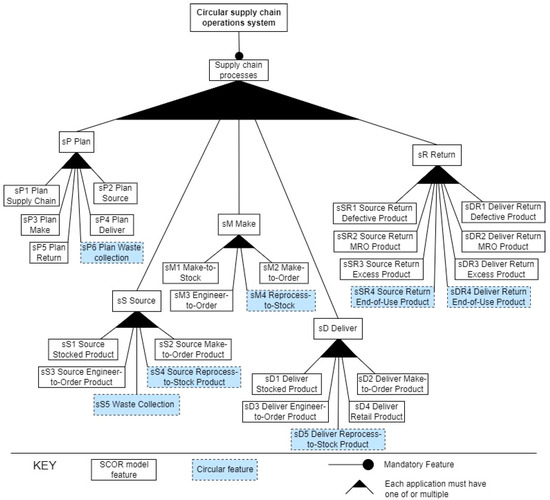
Figure 2.
Feature diagram of a circular supply chain operations system.
The model shows that a company can apply one or more of the processes but not necessarily all. The feature model includes processes from the SCOR model (not shaded) and additional circular processes identified in this study (shaded). If a company includes a feature from a feature model (which is a process) at a higher node such as make, it must use at least one of the sub-features, such as reprocess-to-stock.
4.3. Survey Results
Respondents filled in the economic activities they recognized in their company, based on the UN’s International Standard Industrial Classification of all economic activities (ISIC). The UN notes that this is a comprehensive framework within which economic data can be collected and reported for economic analysis. The classification is used for national activity classification around the world. We used revision 4, currently the latest revision, published in 2008, which includes 21 different activities [41]. We added manufacturing of food products as a separate activity, in addition to manufacturing, because we found it of interest to separately analyze trends in the food sector. Our respondents identified 14 of the 21 economic activities (Figure 3). The economic activities of one respondent were undefined as it was unclear what the respondent referred to. The figure indicates that our respondents came mostly from companies in wholesale and retail trade, agri-food, and water- and waste-related sectors.
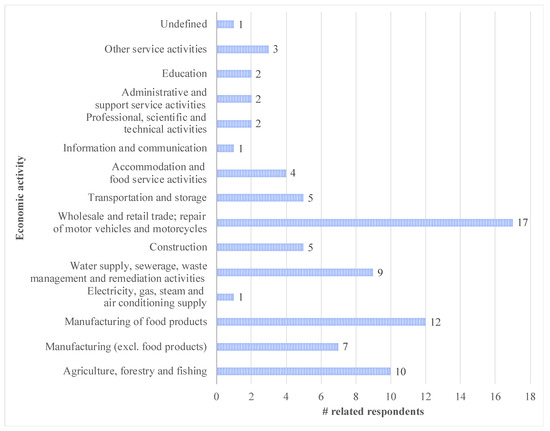
Figure 3.
Economic activities recognized by respondents.
4.3.1. Domain Processes
Respondents could answer yes or no to the question if they recognized the processes we described. The responses helped us to identify to what extent the processes are applied in practice. The first four plan processes were recognized by most respondents, and the last two were recognized less (Figure 4). However, the process plan return, which is important in CE, was recognized by fewer than half of the respondents whereas the newly added process plan waste collection by more than half.
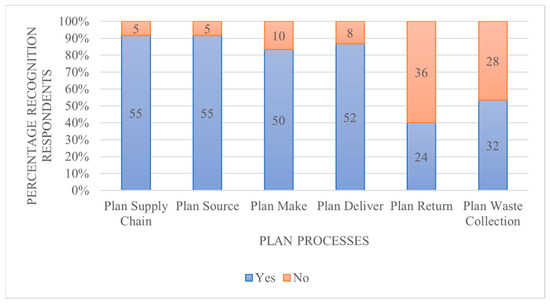
Figure 4.
Plan processes recognized by respondents.
Although sourcing was recognized by respondents slightly less often than planning, it was still well-known to the respondents (Figure 5). The data shows that many companies do not apply all the different source types.
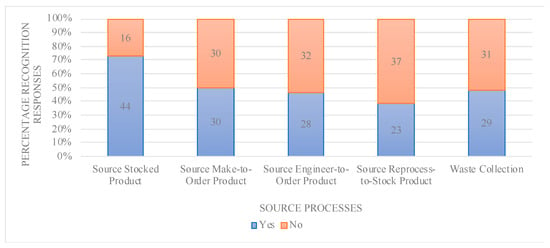
Figure 5.
Source processes recognized by respondents.
Many respondents recognized the newly added circular source processes, namely, source reprocess-to-stock and waste collection. This clearly shows the presence of these processes in practice although they are not part of the SCOR model. The make and deliver processes are shown in Figure 6 and Figure 7, respectively.
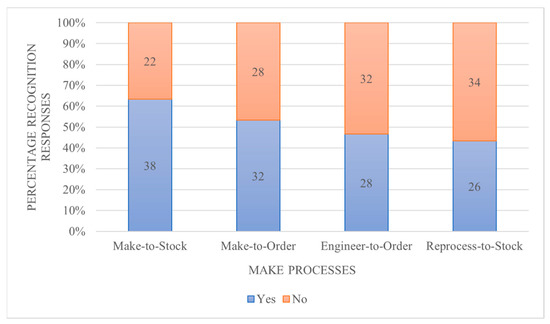
Figure 6.
Make processes recognized by respondents.
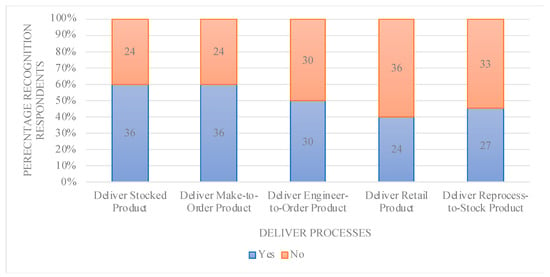
Figure 7.
Deliver processes recognized by respondents.
The figures show that many respondents recognized many of the make and deliver processes—at least 24 respondents for each process. Specifically, the added circular processes reprocess-to-stock and deliver reprocess-to-stock were recognized by 26 and 27 respondents, respectively. This also shows that these processes are widely used by companies in practice although they are not part of SCOR.
Figure 8 shows the results of the last processes of the survey, namely, related to the return process. In the survey, the source return and deliver return processes were combined and described as return, as this made the survey clearer and would make no difference to the results. We assumed that when a company has the source return process, it also has the deliver return process. Additionally, we assumed that when respondents recognized a return process, they recognized both source return and deliver return. The return processes were generally recognized less often than other processes. Nevertheless, multiple companies are applying them. The added circular process return end-of-use product was actually better recognized than the two SCOR processes return MRO product and return excess product.
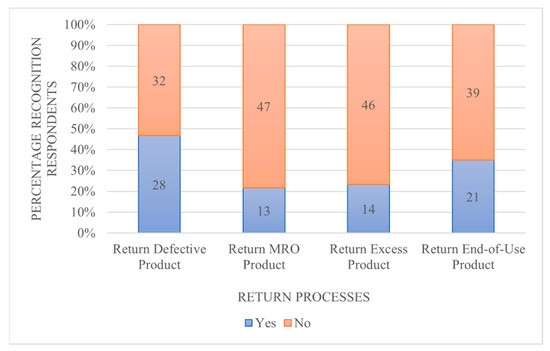
Figure 8.
Return processes recognized by respondents.
4.3.2. Cross Relations among Processes
We looked at the relations of all processes with the ISIC economic activities listed in Table 3. The cross relations among processes and economic activities are shown in Table 4. When a process in a column was recognized by a respondent, the corresponding cell in the row matching the economic activity of the company of the respondent is shaded, otherwise, it is left blank. The processes source return and deliver return are merged for the sake of simplicity and thus sSR1 and sDR1 are, for instance, referred to as sR1.

Table 3.
ISIC economic activities identified by respondents.

Table 4.
All processes recognized by respondents categorized by economic activity. (A shaded cell indicates that the associated respondent identified in the first column recognized the corresponding process given in the first row).
Below we first describe the plan processes, followed by the source, make, deliver, and return processes. Then, we focus on the economic activities and finally comment on the feature diagram (Figure 2) and the responses in general.
The table shows that all plan processes except for plan return and plan waste collection were recognized across almost all economic activities. The various source, make, and deliver processes were not identified across all economic activities. It is interesting to see that different economic activities have different source, make, and deliver processes, indicating that different types of companies use different types of processes. Although the processes are scattered across the different economic activities, it can be seen that the process waste collection is not used as often by companies in the economic activity of manufacturing of food products. The same can be observed about the source reprocess-to-stock, reprocess-to-stock, and deliver reprocess-to-stock processes. By comparison, most companies within the waste sector recognize the processes plan waste collection, waste collection, reprocess-to-stock, and deliver reprocess-to-stock. Although the (plan) waste collection process was mostly added for the waste sector, it was also partially found in most other economic activities. Additionally, 20 respondents recognized reprocess-to-stock when recognizing waste collection, but nine respondents did not.
The return processes were recognized within a restricted set of economic activities as compared to the other processes, which could also be seen in Figure 8. In particular, return MRO product and return excess product were recognized by fewer respondents in our sample, and thus in few economic activities. In particular, companies in agriculture, forestry and fishing or food service activities did not recognize many return processes. In total there were 21 companies that did not recognize any return process, which is one-third of all respondents.
The feature model shown in Figure 2 suggests that each company has one or more of the five major SCOR processes. Table 4 proves that is in fact the case in practice. The feature diagram included an additional one or more relations at level 2. This is also shown to be valid in practice, as each company has one or more level 2 processes corresponding to each of the five major SCOR processes; some companies, for instance, have one source process, but others recognize all five source processes.
4.3.3. Process Relations
We asked for multiple relations between processes and the first question was about whether companies plan waste collection for the process waste collection. There were 20 respondents that recognized this and 11 respondents that did not. The proportion of the respondents as a percentage of the total number of respondents is shown in Figure 9. Five respondents provided text which showed that they did not have these two processes and were therefore not included.
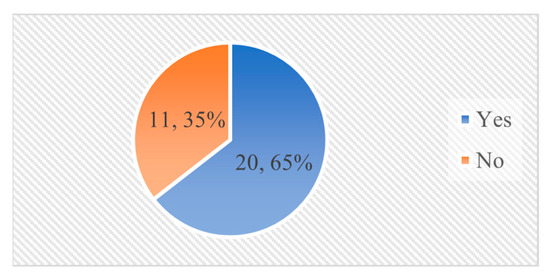
Figure 9.
Companies planning waste collection for waste collection.
We also asked respondents whether their company sourced products that have been returned in order to reprocess or deliver them, and thereby tested if there is a relation between return end-of-use product and source processes. The proportion is shown in Figure 10. Some answers were based on our own interpretation of the textual responses the respondents provided. In total, there were 26 respondents that recognized the relationship in practice.

Figure 10.
Companies sourcing returned end-of-use products.
The third question concerning relations was about the process that happens before reprocess-to-stock in a company. We considered the options source reprocess-to-stock and waste collection but also allowed respondents to fill in another option if necessary. Most respondents, namely 13, recognized waste collection comes before reprocess-to-stock; nine respondents recognized source reprocess-to-stock as coming before reprocess-to-stock (Figure 11). Four respondents filled in another response that we could not interpret.
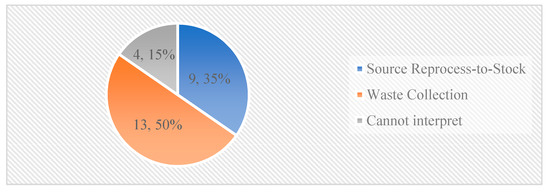
Figure 11.
The process before reprocess-to-stock in companies.
When respondents stated that they recognized deliver reprocess-to-stock, we asked about the process before it. Most respondents stated that reprocess-to-stock comes before, followed by source reprocess-to-stock, and there were three responses we could not interpret (Figure 12).
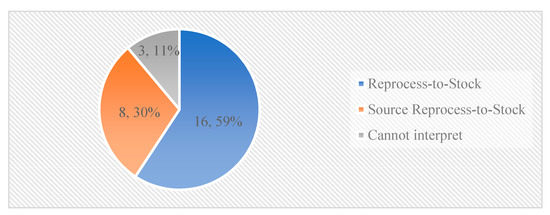
Figure 12.
The process before deliver reprocess-to-stock in companies.
Finally, we asked about the process before deliver retail product. Most respondents filled in source stocked product and nine respondents filled in source reprocess-to-stock product (Figure 13).
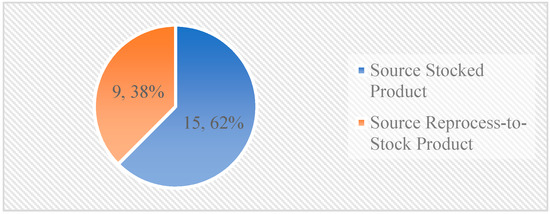
Figure 13.
The process before deliver retail product in companies.
5. Discussion
This research aimed to identify the circular business processes in supply chains in the state-of-the-practice and identify which processes may be relevant for the SCOR model. When processes are clearly identified, supply chain members can more easily model and evaluate them. It also improves the communication between supply chain members. In this section, we first discuss the interpretations and implications of the results, and then the limitations of the study.
5.1. Processes in the State-of-the-Practice
The first question we researched was about the processes that are used in circular supply chains. The two sub-questions focused on the SCOR and non-SCOR processes. The non-SCOR processes are the new circular processes we identified. It appeared from the results that all processes identified in the domain analysis, including the new circular processes, were used in practice. This shows that the processes defined by SCOR are also used in circular supply chains in practice. More importantly, new circular processes are broadly recognized across multiple economic activities. These new processes used in practice are plan waste collection, source reprocess-to-stock, reprocess-to-stock, deliver reprocess-to-stock, source return end-of-use product, and deliver return end-of-use product. This implies that the current SCOR model may not fully represent circular business processes and that the circular processes we identified and represented in our domain model may be good additions to the SCOR model.
We also observed that the return processes were recognized less often by respondents compared to others, especially the return MRO product and return excess product processes. We expected a different result as return is a circular process and essential for closing the material loop and enabling reuse. One-third of the respondents, however, did not use any return process at all. It was seen that companies in the economic activities of agriculture, forestry and fishing or food service did not recognize many return processes. This may be the case because perishable products cannot easily be returned. Return processes may not be necessary for all companies to incorporate circularity principles as other processes or best practices can also increase circularity; examples are selling or buying the residual streams of a company’s production processes for use in another product, or picking up waste from waste disposing customers in order to recycle it into new materials or products.
Some respondents left comments about processes they missed in the survey and recognized in their business. For instance, one respondent mentioned missing drop shipping in the descriptions. Drop shipping is known as a marketing function where retailers can forward the orders from their customers directly to the manufacturer, who will send the order directly to the customer and get paid by the retailer [42]. It seems as though such activities can be modeled by the SCOR model as suggested by Francia-Arias and Vilchez [43]. Another respondent mentioned missing the repair of products on location. Taking in the product is suggested by the return process, as MRO products are first returned according to SCOR. Nevertheless, it can also be considered as a service and thus a separate make process in the company. A third respondent mentioned that the reuse and return of bottles through packaging deposit should have been included. We consider this process to be similar to the circular process return end-of-use product. Finally, another process that emerged was to give residual streams of production processes or rejected products a second life, as animal feed, for instance. There are different options for residual streams, such as selling or giving away residual products. However, processes related to residual streams may be a good addition to the SCOR model as a make process at level 3.
Some of the processes explained by respondents may be considered as best practices instead of additional processes, such as buying food products that have been rejected based on, for instance, mistakes on the package, and using these as raw materials for a company’s own production process. As all these types of sourcing processes can be based on customer forecasts, customer orders, or availability, we consider them to be already included in our domain.
One area of interest in the responses is that there were multiple respondents in sectors other than the waste sector that recognized plan waste collection or waste collection. About half of the respondents recognized at least one of these. When looking at the textual responses, however, we concluded that some of the companies may not use the processes as we described them. One respondent, for instance, noted that they recycled waste but did not collect it, whereas waste collection was recognized. Moreover, multiple companies that bought residual streams from others seemed to interpret it as the process waste collection. We define waste collection as picking up waste as a service triggered by orders from waste disposing customers. Moreover, residual streams are not necessarily the same as waste streams. Another respondent selling coffee equipment noted that picking up used crockery and equipment at a customer that stopped drinking their coffee as waste collection. However, we would interpret this as return end-of-use product. Nevertheless, although multiple respondents may have misinterpreted these two processes, they were still often correctly recognized in the waste sector, showing their applicability in practice. The other companies may not have fully recognized themselves in other processes. Thus, it would be of interest to undertake in-depth research on how these processes can be incorporated into the SCOR model.
Finally, it was noted that multiple respondents recognized a source process, without recognizing the corresponding make or deliver process, or vice versa (e.g., respondents 20, 27, 38, and 57). There may be relations between processes other than those proposed by the SCOR model, or companies may have misunderstood some.
5.2. Process Relations
The other question we researched concerned the relations between circular business processes found in practice. In general, all relations we proposed were recognized to various degrees. We did not find additional relations in our responses. However, some responses can be doubted. There were, for instance, 20 respondents that recognized plan waste collection before waste collection, and two of them did not recognize either of the processes. Additionally, four respondents indicated “no” for the relation, while only recognizing the process plan waste collection and not waste collection. However, as most relations were still recognized by multiple respondents, we can assume that they indeed represent the state-of-the-practice.
More research is needed regarding the extra processes mentioned by the different respondents. Research should be conducted about how the SCOR model could be used to model them, or how the model can be improved; in particular, the process concerning residual streams of companies would benefit from additional research at level 3. Research on the application of the return process in circular supply chains is also of interest because it was recognized less in practice than one would expect. Finally, case studies on the proposed circular processes in our domain analysis and their relations may provide additional validation of our domain in practice. These added circular processes need more research to define the specific processes at level 3.
5.3. Limitations
Multiple limitations must be considered for this research. First, there is a high probability of measurement error, as indicated by Ponto [44]. The questionnaire may not have reflected the processes accurately, which could have led to incorrect responses. Some respondents mentioned in the comments that they found the survey difficult to fill in or clearly identify the processes in their company. Respondents may have wrongly interpreted the questions as we were not available to provide clarification while the respondent was answering the questions. We saw that there were respondents that recognized specific relations, without recognizing the processes mentioned in these relations. This shows that they misinterpreted either the processes, the relations, or both.
Furthermore, the non-random sampling technique chosen provides a less accurate estimate of the population compared to random sampling according to Kelley and Clark [37]. This can result in some coverage error as important respondents may have no chance of being included in the sample due to the method of sampling used [44]. Additionally, there may still be companies with interesting, additional circular processes which did not fill in the survey. Most of the respondents in our sample include companies from the Netherlands, which could have influenced the results. We did not have full control over the respondents because the snowballing method was partially used, leading to sampling error. A sampling error happens when respondents in the sample are not representative of the target population [37,44].
Although there were limitations, we carefully followed the steps of the survey protocol in the literature to gather sufficient and relevant responses. The respondents could choose to stay anonymous, which reduced the degree to which they would present themselves favorably for self-presentation [38]. In addition, the response rate was high for an online survey, namely 46%. Thus, the nonresponse error was low in our research.
6. Conclusions
This research aimed to identify the circular business processes in supply chains in the state-of-the practice through a survey study. Other studies indicating that processes for circular supply chain management are missing in the SCOR model were primarily theoretical investigations. This study contributes by capturing the current state-of-the practice. We looked at SCOR processes, in addition to non-SCOR, circular processes and relations between the processes. We aimed to identify circular processes based on the state-of-the-practice that may be valuable additions to the SCOR model. We developed a domain model including existing SCOR business processes and new circular business processes based on the analysis of the 6R framework.
All SCOR and non-SCOR processes identified in the domain were recognized in practice in circular supply chains. Thus, we can conclude that the current SCOR model may not fully represent circular business processes, and the new circular processes we identified may be valuable additions to the SCOR model. These new processes are: plan waste collection, source reprocess-to-stock, reprocess-to-stock, deliver reprocess-to-stock, source return end-of-use product, and deliver return end-of-use product. Other processes identified by our respondents, such as buying residual streams, were considered best practices for circularity instead of new processes. We also noticed that the return processes of SCOR were used less in practice than other processes, even though they are essential aspects of circular economy.
Our results provide strong evidence that the current SCOR model needs to be improved. However, the new processes we suggest are based on the limited number of economic sectors we were able to cover in our study. Therefore, future research should clarify how these and other circular processes should be incorporated into the SCOR model.
Author Contributions
Conceptualization, A.K. and B.T.; methodology, A.K. and B.T.; validation, B.T., A.K. and T.v.E.; formal analysis, T.v.E., A.K. and B.T.; investigation, T.v.E.; data curation, T.v.E.; writing—original draft preparation, T.v.E.; writing—review and editing, T.v.E., A.K. and B.T.; visualization, T.v.E.; supervision, B.T. and A.K.; project administration, A.K. All authors have read and agreed to the published version of the manuscript.
Funding
This research received no external funding.
Institutional Review Board Statement
Not applicable.
Informed Consent Statement
Not applicable.
Data Availability Statement
Data is contained within the article.
Conflicts of Interest
The authors declare no conflict of interest.
Appendix A. Survey Questions
- All survey questions are displayed in italic
Appendix A.1. Is Your Company Circular?
With the rapid world’s population growth and our consumption style, we are depleting the world’s finite resources. Does your company have circular ambitions, and do you want to contribute to a circular economy?
With a few simple questions, we want to identify current conventional and circular business practices used within businesses as part of my MSc thesis project. In this survey we have grouped these processes into five well-known categories, which are: planning, sourcing, making, delivering and returning. In most of the survey, we ask you to answer a simple YES or NO question about whether these processes are present or absent in your company.
The survey will take you less than 10 minutes, and at the end of the survey you can give us additional comments when necessary. You can choose to stay anonymous if you want, yet your company name will not be used in any publications.
Appendix A.2. General Question
To which sectors does your company mainly relate to? *You can fill in one or more economic activity of the standard ISIC classification.

Table A1.
ISIC economic activities.
Table A1.
ISIC economic activities.
| o | Agriculture; forestry and fishing | o | Financial and insurance activities |
| o | Mining and quarrying | o | Real estate activities |
| o | Manufacturing | o | Professional, scientific and technical activities |
| o | Manufacturing of food products | o | Administrative and support service activities |
| o | Electricity, gas, steam and air conditioning supply | o | Public administration and defence; compulsory social security |
| o | Water supply; sewerage, waste management and remediation activities | o | Education |
| o | Construction | o | Human health and social work activities |
| o | Wholesale and retail trade; repair of motor vehicles and motorcycles | o | Arts, entertainment and recreation |
| o | Transportation and storage | o | Other service activities |
| o | Accommodation and food service activities | o | Activities of households as employers; undifferentiated goods- and services- producing activities of households for own use |
| o | Information and communication | o | Activities of extraterritorial organizations and bodies |
| o | Other… |
- 1.
- Plan processes
Companies make different kinds of plans for their operations. We define 6 planning processes. Below are the names of the planning processes with simple examples:
- 1.1.
- Plan Supply Chain: A baker makes strategic plans for the company in general
- 1.2.
- Plan Source: A baker makes a planning for the sourcing (purchasing) of flour
- 1.3.
- Plan Make: A baker makes a planning for baking bread (e.g., a weekly baking plan)
- 1.4.
- Plan Deliver: A baker makes a planning for delivering bread to customers
- 1.5.
- Plan Return: Mediamarkt makes a planning for how to deal with the return of phones through forecast
- 1.6.
- Plan Waste Collection: A recycling company makes a planning for picking up waste through forecast.

Table A2.
Do you recognize the following plan processes in your company?
Table A2.
Do you recognize the following plan processes in your company?
| Yes | No | |
|---|---|---|
| 1.1 Plan Supply Chain | o | o |
| 1.2 Plan Source | o | o |
| 1.3 Plan Make | o | o |
| 1.4 Plan Deliver | o | o |
| 1.5 Plan Return | o | o |
| 1.6 Plan Waste Collection | o | o |
- 2.
- Source processes
Companies source (purchase) inputs like raw materials, subassemblies, products and/or services. We define the following 5 sourcing processes, explained using simple examples:
- 2.1.
- Source Stocked Product: A restaurant in IKEA sources food before knowing what and how much customers will eat. Sourcing is based on sales forecast.
- 2.2.
- Source Make-to-Order Product: A restaurant where customers are required to make reservation, the sourcing of ingredients required for meals is based on the number of reservations and menus selected. Sourcing is based on customer order.
- 2.3.
- Source Engineer-to-Order Product: A restaurant sources ingredients required for the meals of a wedding based on specified preferences of the couple (not necessarily based on fixed menus). Sourcing is based on the unique preferences of a customer order.
- 2.4.
- Source Reprocess-to-Stock Product: A second-hand clothing sorting- and distribution center sources already used clothing depending on the amount available. Sourcing is based on the availability of materials.
- 2.5.
- Waste Collection: A company that recycles waste obtains orders from customers to collect waste and then picks it up. Sourcing is based on service contracts of waste disposing customers and availability of waste, yet independent of sales forecast. (Sourcing based on collecting household waste, collecting empty beer glasses, etc. fall in this category).

Table A3.
Do you recognize the following source processes in your company?
Table A3.
Do you recognize the following source processes in your company?
| Yes | No | |
|---|---|---|
| 2.1 Source Stocked Product | o | o |
| 2.2 Source Make-to-Order Product | o | o |
| 2.3 Source Engineer-to-Order Product | o | o |
| 2.4 Source Reprocess-to-Stock Product | o | o |
| 2.5 Waste Collection | o | o |
*Answer if you checked ‘Yes’ for Waste Collection* Does your company Plan Waste Collection for the process Waste Collection?
- ○
- Yes
- ○
- No
- ○
- Other …
Does your company source used products that have been returned to your company from customers, in order to remake or deliver it? (e.g., A phone company taking in used phones, after which they are sourced to be remanufactured)
- ○
- Yes
- ○
- No
- ○
- Other …
- 3.
- Make processes
Companies create services or produce products. We define the following 4 types of make processes, explained using simple examples:
- 3.1.
- Make-to-Stock: A restaurant in IKEA makes food ready for the customer to pick, before knowing what and how much customers will eat. Production is based on sales forecast with standard outputs.
- 3.2.
- Make-to-Order: A restaurant where customers are required to make reservation, makes ordered meals from already defined menus. Production or completion is based on customer order within standard outputs.
- 3.3.
- Engineer-to-Order: A restaurant makes food ready for a wedding, based on the specified preferences of the couple. Production is based on the unique preferences of a customer order and results in unique outputs.
- 3.4.
- Reprocess-to-Stock: A company that recycles waste (as its core or side business) recycles waste materials, depending on the amount and quality of waste that is collected. Production is based on the quality and/or quantity of incoming supplies and results in outputs of different quality and quantity.

Table A4.
Do you recognize the following make processes in your company?
Table A4.
Do you recognize the following make processes in your company?
| Yes | No | |
|---|---|---|
| 3.1 Make-to-Stock | o | o |
| 3.2 Make-to-Order | o | o |
| 3.3 Engineer-to-Order | o | o |
| 3.4 Reprocess-to-Stock | o | o |
*Answer if you checked ‘Yes’ for Reprocess-to-Stock* The process Reprocess-to-Stock in your company, takes place after the process
- ○
- … Waste Collection (e.g., A Waste recycling company that recycles waste after collecting it)
- ○
- … Source Reprocess-to-Stock Product (e.g., A second-hand clothing sorting- and distribution center that sorts and makes used clothing ready for reuse, after sourcing the used clothes)
- ○
- Other …
- 4.
- Deliver processes
Companies deliver finished goods or services to customers. We define the following 5 deliver processes, explained using simple examples:
- 4.1.
- Deliver Stocked Product: IKEA sells finished food at its restaurant that was made ready before knowing what and how much customers would eat. Delivery is based on sales forecast with standard outputs.
- 4.2.
- Deliver Make-to-Order Product: A restaurant delivers ordered meals from a menu to customers. Delivery is based on customer order with standard outputs.
- 4.3.
- Deliver Engineer-to-Order Product: A restaurant delivers food at a wedding according to the unique preferences of the couple. Delivery is based on the unique preferences of a customer with unique outputs.
- 4.4.
- Deliver Retail Product: A supermarket stocks its shelf with finished products and sells it to customers. Delivery is based on acquiring, merchandising and selling finished goods at a retail store.
- 4.5.
- Deliver Reprocess-to-Stock Product: A waste recycling company delivers recycled paper. Delivery is based on products that are sourced or made based on the quality and/or quantity of incoming supplies.

Table A5.
Do you recognize the following deliver processes in your company?
Table A5.
Do you recognize the following deliver processes in your company?
| Yes | No | |
|---|---|---|
| 4.1 Deliver Stocked Product | o | o |
| 4.2 Deliver Make-to-Order Product | o | o |
| 4.3 Deliver Engineer-to-Order Product | o | o |
| 4.4 Deliver Retail Product | o | o |
| 4.5 Deliver Reprocess-to-Stock Product | o | o |
*Answer if you checked ‘Yes’ for Deliver Reprocess-to-Stock Product* The process Deliver Reprocess-to-Stock Product in your company, takes place after the process.
- ○
- …Reprocess-to-Stock (e.g., A waste recycling company delivering recycled paper, after recycling it at the company)
- ○
- …Source Reprocess-to-Stock Product (e.g., A second-hand company that delivers products right after sourcing it)
- ○
- Other…
*Answer if you checked ‘Yes’ for Deliver Retail Product* The process Deliver Retail Product in your company, takes place after the process….
- ○
- …Source Make-to-Stock Product (e.g., A supermarket that sources finished food products and sells them at the store)
- ○
- …Source Reprocess-to-Stock Product (e.g., A second-hand shop that sources/ receives used products and sells them at the store)
- ○
- Other…
- 5.
- Return processes
Companies return and receive products from customers. We define the following 4 return processes, explained using simple examples:
- 5.1.
- Return Defective Product: Returning a defective product to the company and receiving the product at the company, as defined by company rules. (e.g., A toys manufacturer identifying and receiving a baby born, which was delivered defective as it could not make a sound).
- 5.2.
- Return MRO Product: Returning a Maintenance, Repair and Overhaul (MRO) product or company assets to the company and receiving it at the company. The purpose is to repair or upgrade it. (e.g., A computer company returning and receiving a computer from a customer for repair).
- 5.3.
- Return Excess Product: Returning excess or aging inventory to the company and receiving it at the company, according to certain terms, in order to reallocate it to a place that can sell the product (e.g., A distribution center that receives clothes from a clothing shop that could not sell anymore in its city, and sends it to be sold in another place).
- 5.4.
- Return End-of-Use Product: Returning a used product to the company and receiving it at the company, in order to reuse, refurbish or remanufacture it (e.g., When a customer returns its used clothes to H&M in order for H&M to deliver it to another organization who can sell it).

Table A6.
Do you recognize the following return processes in your company?
Table A6.
Do you recognize the following return processes in your company?
| Yes | No | |
|---|---|---|
| 5.1 Return Defective Product | o | o |
| 5.2 Return MRO Product | o | o |
| 5.3 Return Excess Product | o | o |
| 5.4 Return End-of-Use Product | o | o |
Appendix A.3. Other
Are there any processes that you missed in this survey which are present in your company? If so, which process(es) did you miss?
………
Do you have any more comments about the processes of your company, or about what you filled in?
………
What is the name of your company?
………
What is your role in the company?
………
Where did you find this survey?
- ○
- Via a post on LinkedIn
- ○
- Someone I know send it to me
- ○
- I was contacted via mail/message
- ○
- Other…
References
- UN. World Population Prospects: The 2017 Revision, Key Findings and Advance Tables; United Nations: New York, NY, USA, 2017. [Google Scholar]
- FAO. Global Food Losses and Food Waste—Extent, Causes and Prevention; FAO: Rome, Italy, 2011. [Google Scholar]
- OECD. Perspectives on Global Development 2012—Social Cohesion in a Shifting World; OECD Publishing: Paris, France, 2011. [Google Scholar]
- Ellen MacArthur Foundation. Towards the Circular Economy. Economic and Business Rationale for an Accelerated Transition; EMF: Cowes, UK, 2013; Volume 1. [Google Scholar]
- UN. Goal 12: Ensure Sustainable Consumption and Production Patterns. Available online: https://www.un.org/sustainabledevelopment/sustainable-consumption-production/ (accessed on 2 September 2020).
- Ellen MacArthur Foundation. Towards the Circular Economy. Opportunities for the Consumer Goods Sector; EMF: Cowes, UK, 2013; Volume 2. [Google Scholar]
- Ellen MacArthur Foundation. Towards the Circular Economy. Accelerating the Scale-up Across Global Supply Chains; EMF: Cowes, UK, 2014; Volume 3. [Google Scholar]
- Ellen MacArthur Foundation. Growth within: A Circular Economy Vision for a Competitive Europe; EMF: Cowes, UK, 2015. [Google Scholar]
- Jawahir, I.S.; Bradley, R. Technological Elements of Circular Economy and the Principles of 6R-Based Closed-Loop Material Flow in Sustainable Manufacturing. Procedia CIRP 2016, 40, 103–108. [Google Scholar] [CrossRef] [Green Version]
- McDowall, W.; Geng, Y.; Huang, B.; Barteková, E.; Bleischwitz, R.; Türkeli, S.; Kemp, R.; Doménech, T. Circular economy policies in China and Europe. J. Ind. Ecol. 2017, 21, 651–661. [Google Scholar] [CrossRef] [Green Version]
- Ghisellini, P.; Cialani, C.; Ulgiati, S. A review on circular economy: The expected transition to a balanced interplay of environmental and economic systems. J. Clean. Prod. 2016, 114, 11–32. [Google Scholar] [CrossRef]
- PACE. The Circularity GAP Report 2020; Ruparo: Amsterdam, The Netherlands, 2020. [Google Scholar]
- Huan, S.H.; Sheoran, S.K.; Wang, G. A review and analysis of supply chain operations reference (SCOR) model. Supply Chain Manag. Int. J. 2004, 9, 23–29. [Google Scholar] [CrossRef]
- Lambert, D.M.; García-Dastugue, S.J.; Croxton, K.L. An evaluation of process—Oriented supply chain management frameworks. J. Bus. Logist. 2005, 26, 25–51. [Google Scholar] [CrossRef]
- Ntabe, E.N.; LeBela, L.; Munsona, A.D.; Santa-Eulaliab, L.A. A systematic literature review of the supply chain operations reference (SCOR) model application with special attention to environmental issues. Int. J. Prod. Econ. 2015, 169, 310–332. [Google Scholar] [CrossRef]
- APICS. Supply Chain Operations Reference Model SCOR. Version 12.0; APICS: Chicago, IL, USA, 2017. [Google Scholar]
- APICS. Quick Reference Guide. SCOR Supply Chain Operations Reference Model. 2017. Available online: http://www.apics.org/docs/default-source/scor-p-toolkits/apics-scc-scor-quick-reference-guide.pdf. (accessed on 21 September 2020).
- Xiao, R.; Cai, Z.; Zhang, X. An optimization approach to cycle quality network chain based on improved SCOR model. Prog. Nat. Sci. 2009, 19, 881–890. [Google Scholar] [CrossRef]
- Xiao, R.; Cai, Z.; Zhang, X. An optimization approach to risk decision-making of closed-loop logistics based on SCOR model. Optimization 2012, 61, 1221–1251. [Google Scholar] [CrossRef]
- Tan, Y.; Cai, Z.Y.; Qi, H. A process-based performance analysis for closed-loop agriculture supply chain. In Proceedings of the 2010 International Conference on Intelligent System Design and Engineering Application (ISDEA 2010), Changsha, China, 13–14 October 2010. [Google Scholar]
- Bin, Y.; Zhengying, C. Managing cycle quality chain operation and optimizing cost. In Proceedings of the 2008 International Conference on Wireless Communications, Networking and Mobile Computing (WiCOM 2008), Dalian, China, 12–17 October 2008. [Google Scholar]
- Vegter, D.; van Hillegersberg, J.; Olthaar, M. Supply chains in circular business models: Processes and performance objectives. Resour. Conserv. Recycl. 2020, 162, 105046. [Google Scholar] [CrossRef]
- Kirchherr, J.; Reike, D.; Hekkert, M. Conceptualizing the circular economy: An analysis of 114 definitions. Resour. Conserv. Recycl. 2017, 127, 221–232. [Google Scholar] [CrossRef]
- Ellen MacArthur Foundation. Towards a Circular Economy: Business rationale for an Accelerated Transition; EMF: Cowes, UK, 2015. [Google Scholar]
- Bradley, R.; Jawahir, I.S.; Badurdeen, F.; Rouch, K. A total life cycle cost model (TLCCM) for the circular economy and its application to post-recovery resource allocation. Resour. Conserv. Recycl. 2018, 135, 141–149. [Google Scholar] [CrossRef]
- McDonough, W.; Braungart, M. Cradle to Cradle: Remaking the Way We Make Things; North Point Press: New York, NY, USA, 2002. [Google Scholar]
- Charter, M.; Tischner, U. (Eds.) Sustainable Solutions: Developing Products and Services for the Future; Routledge: New York, NY, USA, 2001. [Google Scholar]
- Ranta, V.; Aarikka-Stenroos, L.; Mäkinen, S.J. Creating value in the circular economy: A structured multiple-case analysis of business models. J. Clean. Prod. 2018, 201, 988–1000. [Google Scholar] [CrossRef]
- European Union. Directive 2008/98/EC of the European Parliament and of the Council of 19 November 2008 on waste and repealing certain Directives. Off. J. Eur. Union. L312/3. Available online: http://data.europa.eu/eli/dir/2008/98/oj (accessed on 25 November 2021).
- Prendeville, S.; Sherry, J. Circular Economy. Is It Enough? Technical Report; EcoDesign Centre: Wales, UK, 2014. [Google Scholar]
- Castellani, V.; Sala, S.; Mirabella, N. Beyond the throwaway society: A life cycle-based assessment of the environmental benefit of reuse. Integr. Environ. Assess. Manag. 2015, 11, 373–382. [Google Scholar] [CrossRef] [PubMed]
- Ghisellini, P.; Ulgiati, S. Circular economy transition in Italy. Achievements, perspectives and constraints. J. Clean. Prod. 2020, 243, 118360. [Google Scholar] [CrossRef]
- Reichel, A.; De Schoenmakere, M.; Gillabel, J. Circular Economy in Europe. Developing the Knowledge Base; European Environment Agency: Copenhagen, Danmark, 2016.
- Zhang, X.; Badurdeen, F.; Rouch, K.; Jawahir, I.S. On improving the product sustainability of metallic automotive components by using the total life-cycle approach and the 6R methodology. In Proceedings of the 11th Global Conference on Sustainable Manufacturing, Berlin, Germany, 23–25 September 2013; pp. 194–199. [Google Scholar]
- Steinhilper, R.; Weiland, F. Exploring New Horizons for Remanufacturing an Up-to-Date Overview of Industries, Products and Technologies. Procedia CIRP 2015, 29, 769–773. [Google Scholar] [CrossRef]
- Huang, S.H.; Sheoran, S.K.; Keskar, H. Computer-assisted supply chain configuration based on supply chain operations reference (SCOR) model. Comput. Ind. Eng. 2005, 48, 377–394. [Google Scholar] [CrossRef]
- Kelley, K.; Clark, B.; Brown, V.; Sitzia, J. Good practice in the conduct and reporting of survey research. Int. J. Qual. Health Care 2003, 15, 261–266. [Google Scholar] [CrossRef] [PubMed] [Green Version]
- De Leeuw, E.; Hox, J.; Dillman, D. International Handbook Of Survey Methodology (2008); Taylor & Francis: New York, NY, USA, 2008. [Google Scholar]
- Chopra, S.; Meindl, P. Supply Chain Management—Strategy, Planning, and Operation, 6th ed.; Pearson Education: New York, NY, USA, 2016. [Google Scholar]
- Sol, L. The SCOR model: A case for circular supply chain management. In Information Technology Group; Wageningen University: Wageningen, The Netherlands, 2018; p. 72. [Google Scholar]
- UN. International Standard Industrial Classification of All Economic Activities—Revision 4; United Nations: New York, NY, USA, 2008. [Google Scholar]
- Scheel, N.T. Drop Shipping as a Marketing Function: A Handbook of Methods and Policies; Quorum Books: Westport, CT, USA, 1990. [Google Scholar]
- Francia-Arias, G.; Marín-Vílchez, J.; Macassi-Jauregui, I.; Raymundo-Ibañez, C.; Dominguez, F. SCOR Model. for a Dual-Channel Supply Chain using Drop Shipping to Reduce Overstock in Small- and Medium-Sized Retail. Enterprises. IOP Conf. Ser. Mater. Sci. Eng. 2020, 796, 012010. [Google Scholar] [CrossRef]
- Ponto, J. Understanding and Evaluating Survey Research. J. Adv. Pract. Oncol. 2015, 6, 168–171. [Google Scholar] [PubMed]
Publisher’s Note: MDPI stays neutral with regard to jurisdictional claims in published maps and institutional affiliations. |
© 2021 by the authors. Licensee MDPI, Basel, Switzerland. This article is an open access article distributed under the terms and conditions of the Creative Commons Attribution (CC BY) license (https://creativecommons.org/licenses/by/4.0/).